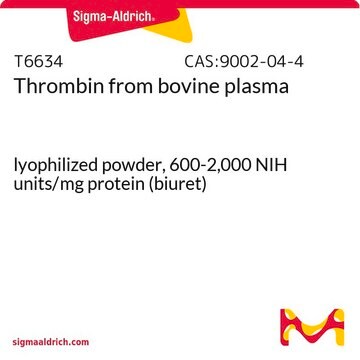T7513
Thrombin from bovine plasma
lyophilized powder, ≥2,000 NIH units/mg protein (E1%/280 = 19.5)
Synonym(s):
Factor IIa
About This Item
Recommended Products
form
lyophilized powder
Quality Level
specific activity
≥2,000 NIH units/mg protein (E1%/280 = 19.5)
mol wt
heavy chain ~33 kDa
light chain ~5 kDa
UniProt accession no.
application(s)
diagnostic assay manufacturing
storage temp.
−20°C
Gene Information
cow ... F2(280685)
Looking for similar products? Visit Product Comparison Guide
Biochem/physiol Actions
Unit Definition
Physical form
Analysis Note
Other Notes
inhibitor
Signal Word
Danger
Hazard Statements
Precautionary Statements
Hazard Classifications
Eye Irrit. 2 - Resp. Sens. 1 - Skin Irrit. 2 - STOT SE 3
Target Organs
Respiratory system
Storage Class Code
11 - Combustible Solids
WGK
WGK 2
Flash Point(F)
Not applicable
Flash Point(C)
Not applicable
Certificates of Analysis (COA)
Search for Certificates of Analysis (COA) by entering the products Lot/Batch Number. Lot and Batch Numbers can be found on a product’s label following the words ‘Lot’ or ‘Batch’.
Already Own This Product?
Find documentation for the products that you have recently purchased in the Document Library.
Customers Also Viewed
Our team of scientists has experience in all areas of research including Life Science, Material Science, Chemical Synthesis, Chromatography, Analytical and many others.
Contact Technical Service









